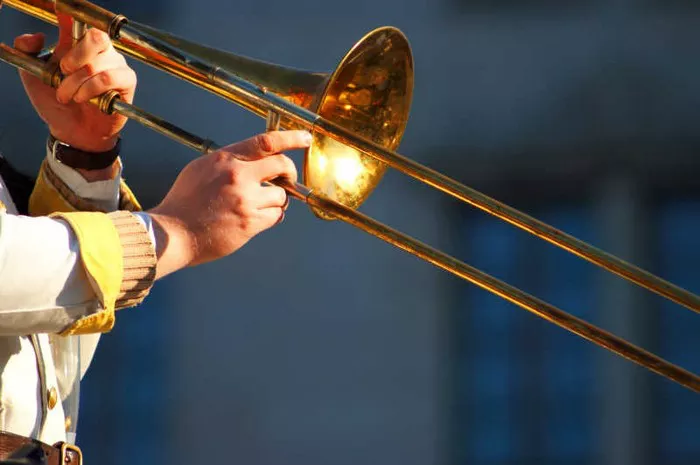In the symphonic tapestry of musical instruments, the trombone stands out as a commanding presence, often recognized for its rich and resonant contributions to ensemble performances. Yet, beyond its role as a vital ensemble member, the trombone possesses a soloistic prowess that captivates audiences with its distinctive timbre and expressive potential. In this exploration of musical depth, we delve into the question: Can the trombone be played solo? From its historical evolution to virtuosic possibilities, we unveil the elegance and power of the solo trombone.
The Origins of Solo Trombone
The trombone, a brass instrument characterized by its telescopic slide, has a storied history that dates back centuries. In the early stages of its development, the trombone was commonly featured in ensemble settings, lending its majestic voice to religious ceremonies, royal courts, and orchestras. The instrument’s versatility allowed it to play both melodic and supporting roles within these ensembles.
As musical tastes evolved, so did the role of the trombone. During the Baroque period, composers such as Johann Sebastian Bach incorporated the trombone into compositions, utilizing its unique timbre for melodic lines and solos. However, it wasn’t until the Romantic era that the trombone began to emerge as a solo instrument in its own right.
Can Trombone Be Played Solo?
Absolutely, the trombone can shine as a solo instrument. Beyond its role in ensembles, it boasts a rich solo repertoire. Its warm timbre and expressive capabilities allow for captivating performances across genres. From classical concertos to jazz improvisations, trombonists navigate technical challenges and convey emotion through extended techniques. Historic compositions by composers like Ferdinand David and contemporary explorations push the instrument’s boundaries. The trombone’s solo voice, marked by virtuosity and artistry, resonates with audiences, proving that it’s not just an ensemble player but a soloist capable of delivering powerful, evocative, and unforgettable musical experiences.
Solo Trombone in Various Genres
1. Classical Music:
In the realm of classical music, the solo trombone has made notable contributions to concertos, chamber music, and orchestral solos. The instrument’s rich timbre and expressive qualities add depth to both traditional and contemporary compositions.
2. Jazz and Popular Music:
The trombone’s soloistic capabilities extend to jazz and popular music genres. Jazz trombonists are celebrated for their improvisational prowess, weaving intricate solos within the context of larger ensembles. The trombone’s versatility enables it to transition seamlessly from orchestral settings to jazz clubs and studio recordings.
How to Master Trombone Technique?
Mastering trombone technique requires dedication, practice, and a systematic approach. Begin with proper posture and breathing techniques to support sound production. Focus on the following aspects:
1. Embouchure:
Develop a consistent and flexible embouchure (lip and facial muscles) to produce clear and controlled tones. Practice long tones to improve control over pitch and dynamics.
2. Slide Technique:
Precision in slide movement is crucial. Work on smooth glissandos, lip slurs, and interval jumps to build muscle memory and accuracy.
3. Articulation:
Master various articulation techniques like legato, staccato, and accents. Use syllables (e.g., “ta,” “da,” “ga”) to enhance clarity in tonguing.
4. Flexibility and Range:
Gradually expand your range through exercises targeting high and low registers. Lip slurs and interval studies are effective for building flexibility.
5. Scales and Patterns:
Practice scales, arpeggios, and patterns in different keys to enhance finger dexterity and familiarity with the instrument’s layout.
6. Sight-Reading:
Regularly practice sight-reading to improve your ability to read and perform new music accurately.
Remember, progress takes time, so be patient and persistent. Continuously challenge yourself with new techniques and repertoire to keep improving your trombone playing skills.
See Also: A Comprehensive Guide on How to Play the Trombone
What Solo Repertoire For Trombone?
Trombone solo repertoire spans a wide range of styles and difficulty levels. Here’s a selection of notable pieces across various genres and levels of expertise:
1. Beginner to Intermediate:
Arthur Pryor – “Blue Bells of Scotland”
J.S. Bach – “Minuet in G”
J.S. Bach – “Bourrée” from Suite No. 3 for Cello
A. Corelli – “Sarabande” from Sonata in D minor, Op. 5, No. 7
G.F. Handel – “Hornpipe” from Water Music
J. Ed Barat – “Andante et Allegro”
2. Intermediate to Advanced:
Henri Tomasi – “Concerto for Trombone and Orchestra”
Launy Grøndahl – “Concerto for Trombone and Orchestra”
Frank Martin – “Ballade for Trombone and Piano”
Nino Rota – “Concerto for Trombone and Orchestra”
Alexey Lebedev – “Concerto in One Movement”
Rimsky-Korsakov – “Concerto for Trombone and Band”
3. Advanced to Virtuoso:
Ernst Sachse – “Concertino for Bass Trombone and Orchestra”
Derek Bourgeois – “Trombone Concerto”
Lars-Erik Larsson – “Concertino for Trombone and Strings”
Frank Martin – “Concerto for 7 Winds, Timpani, Percussion, and Strings”
Launy Grøndahl – “Concerto for Trombone and Orchestra No. 2”
This list is by no means exhaustive, but it offers a starting point for exploring the diverse world of trombone solo repertoire. As you progress, you’ll find a wealth of classical, contemporary, and even jazz-inspired works to challenge and showcase your skills.
Conclusion
The solo trombone, once an integral part of ensembles, has blossomed into a captivating solo instrument with a rich and storied history. From its emergence in orchestral solos and chamber music to its virtuosic role in concertos and jazz improvisations, the trombone has proven its capacity to command the spotlight. As the instrument continues to evolve and embrace new genres and styles, its solo voice remains a source of inspiration, innovation, and the enduring magic of musical expression.


